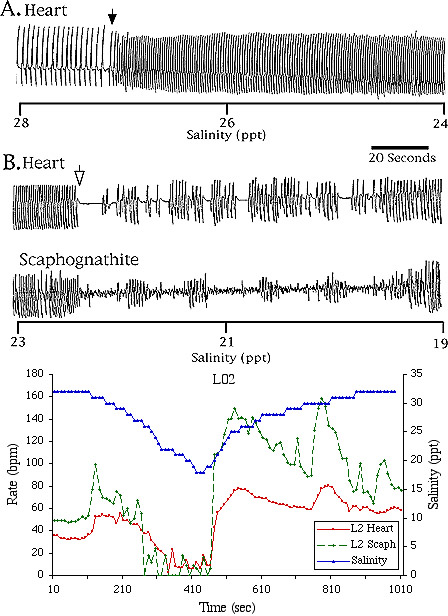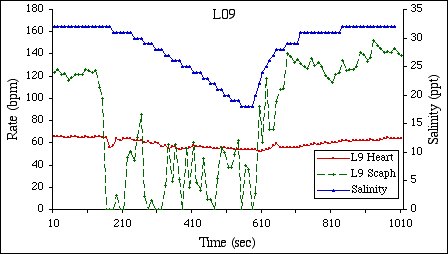Lobsters in estuaries
Estuaries, such as the Great Bay estuary in N.H. are characterized by large fluctuations in temperature and salinity. Animals living in an estuary, like lobsters, have evolved physiological and behavioral mechanisms to optimize their survival in this complex and occasionally stressful habitat. We have been carrying out field and laboratory studies for many years on this topic. The field studies are described elsewhere on this website. The laboratory studies include investigations of their: 1) behavioral responses of lobsters to drops in salinity; 2) salinity receptors; 3) ability to behaviorally thermoregulate; 4) thermal receptors; 5) ability to osmoregulate; 5) locomotion and biorhythms and; 6) cardioregulatory physiology. Each of these will be discussed briefly below.
Responses to low salinity
Lobsters tend to avoid low salinity water. We have demonstrated this using several different behavioral assays (Jury et al., 1994a). Interestingly, we find that male and female lobsters differ somewhat in their aversive responses. Males appear to be less responsive, which might explain why there are more male lobsters the further one moves up into the estuary. Females might find low salinity water more aversive because their metabolism increases more than males when they are exposed to low salinity water (see below).
Relevant Papers:
Jury, S., M.T. Kinnison, W.H. Howell, and W.H. Watson III. 1994. Metabolic responses of lobsters exposed to reduced salinity. J.Exp. Marine Biol. and Ecol.176: 167-185.
Jury, S., M.T. Kinnison, W.H. Howell, and W.H. Watson III. 1994. The behavior of lobsters in response to reduced salinity. J. Exp. Marine Biol. and Ecol. 180: 23-37.
Jury, S.H., W.H. Howell, and W.H. Watson III. 1995. Lobster movements in response to a hurricane. Mar. Ecol. Prog. Ser. 119: 305-310.
Dufort, C.G., S. H. Jury, J. M. Newcomb, D. F. O’Grady, III and W. H. Watson, III. 2001. Detection of salinity by the lobster, Homarus americanus. Biol. Bull. 201: 424-34. doi.org/10.2307/1543620
O’Grady, D.F., S.H. Jury and W.H. Watson III. 2001. Use of a treadmill to study the relationship between walking, ventilation and heart rate in the lobster Homarus americanus. Mar. Freshwater Res. 52: 1387-94. doi.org/10.1071/MF01088

Cardiac assays
When many animals, including lobsters, are exposed to novel stimuli, their heart rate changes (see movie below). We have developed a cardiac assay so we can determine the sensitivity of lobsters to salinity and temperature. Fine wire electrodes are placed near the heart and gill bailers (scaphognathites) to record heart and ventilation rate. These electrodes are connected to an impedance device that detects changes in the impedance of the tissues as they move. The signal is then amplified and displayed on a Macintosh computer using MacLab software (http://www.adinstruments.com). We then alter the environment and look for changes in heart rate as indicators that lobsters sense the change (see Figure below).
Cardiac responses to salinity and salinity receptors
Typically, when we slowly drop the salinity of the water in the test chamber lobsters respond with an increase in heart rate when the salinity reaches about 26 ppt, a drop of 6 ppt from the normal salinity of 32 ppt. Then, as the salinity continues to drop, lobsters exhibit a dramatic slowing of their heart rate, or a bradycardia, when the salinity reaches 21 ppt. A typical response is shown in the above recording.
It appears as if the receptors involved in sensing salinity are located in the branchial chamber, although they have yet to be identified.
Dufort, C.G., S. H. Jury, J. M. Newcomb, D. F. O’Grady, III and W. H. Watson, III. 2001. Detection of salinity by the lobster, Homarus americanus. Biol. Bull. 201: 424-34. doi.org/10.2307/1543620
Behavioral thermoregulation
When lobsters are placed in a thermal gradient tank they will move to a location in the tank with a temperature of approximately 16-17°C (Crossin et al. 1999), and avoid water colder than ~5°C and warmer than ~23°C. In general, male lobsters prefer slightly warmer temperatures than females. These responses in the laboratory appear to correlate well with their movements in thermal gradients in the estuary. Steve Jury created a model which will predict the movements of lobsters in an estuary based primarily on their responses to temperature. His model accurately predicts both seasonal movements, and the difference in sex ratios. This finding, and data from numerous tracking studies indicate that lobster movements are strongly influenced by thermal gradients.
Relevant Publications:
Crossin, G., S.A. Al-Ayoub, S.H. Jury, W.H. Howell and W.H. Watson III. (1998) Behavioral thermoregulation in the American lobster, Homarus americanus. J. exp. Biol. 201: 365-74.
Jury, S. H., B. C. Gutzler, J. S. Goldstein, J. T. Carloni and W. H. Watson III. Behavioral thermoregulation of ovigerous American lobsters (Homarus americanus). 2024. Fish. Bull. doi.org/10.1016/j.fishres.2024.107068.
Temperature receptors
The cardiac assay described above has been used to determine the sensitivity of lobsters to changes in temperature. They are very sensitive, detecting changes of <1 °C (Jury and Watson, 200o, citation below). Attempts to locate the receptors they are using to detect changes in temperature have been challenging. While it appears as if the receptors are external, removal of the antennules, antennae and legs do not affect their ability to sense changes in temperature. This is a very exciting area for future investigations.
Jury, S.H. and W.H. Watson III. 2000. Thermosensitivity of the American lobster, Homarus americanus, as determined by cardiac assay. Biol. Bull. 199(3): 257-264.
Osmoregulation
Lobsters are not strong osmoregulators. In fact a better term to describe them is hyperosmoconformers. As the salinity is dropped, their blood osmolarity also drops, but it always stays hyperosmotic to the ambient water. If changes are gradual, they can withstand 5-10 ppt for several days, but further decreases, or prolonged exposure to <10 ppt can be lethal.
In 1994 Steve Jury quantified the energetics of osmoregulation in Homarus americanus and demonstrated that male lobsters use less energy to achieve the same level of hyperosmoregulation as female lobsters. This suggests an energetic advantage for males inhabiting the upper reaches of an estuary. Christina Rockel (now Houchens and now with a Master's Degree), has documented differences in the osmoregulatory capabilities of coastal and estuarine lobsters. Her data suggests that during acclimation to different salinities there is a change in the enzymes that pump ions across the gill membrane (Na+/K+ ATPase). Due to these adjustments estuarine lobsters can survive better at low salinities. We are presently trying to visualize these pumps, quantify the changes and determine why male and female lobsters have different abilities to osmoregulate.
Relevant Publications:
Jury, S., M.T. Kinnison, W.H. Howell, and W.H. Watson III. 1994. Metabolic responses of lobsters exposed to reduced salinity. J.Exp. Marine Biol. and Ecol.176: 167-185.
Jury, S., M.T. Kinnison, W.H. Howell, and W.H. Watson III. 1994. The behavior of lobsters in response to reduced salinity. J. Exp. Marine Biol. and Ecol. 180: 23-37.
Howell, W.H., W.H. Watson III., and S.H. Jury. (1999) Skewed sex ratio in an estuarine lobster (Homarus americanus) population. J. of Shellfish Research 18: 193-201
Watson, W.H. III, A. Vetrovs and W.H. Howell. 1999. Lobster movements in an estuary. Marine Biology 134: 65-75.
Locomotion and rhythms
Lobster movements in the field have a great impact on their distribution and abundance. In the laboratory we have been quantifying their normal patterns of locomotion, as well as factors that influence the distance they travel. One tool we used for this type of study was a lobster "racetrack", which is illustrated below. We have also developed lobster treadmill, which is also pictured below and, more recently we have been using accelerometers both in the laboratory and in the field.
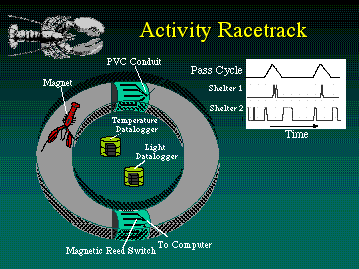
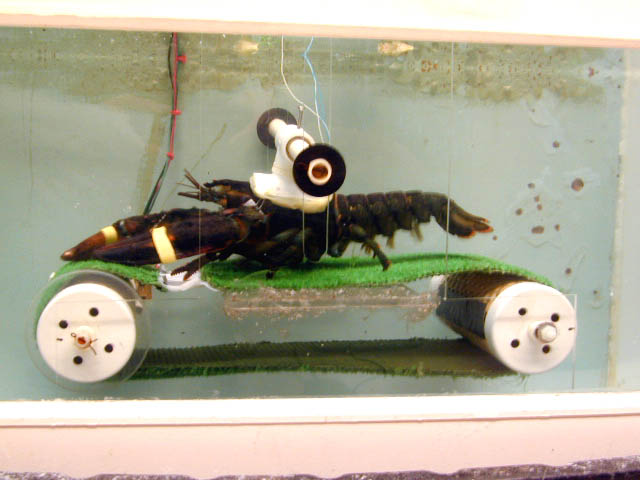
The lobster treadmill has allowed us to investigate the relationship between locomotion and changes in heart and ventilation rate. The figure below shows one example of how heart and ventilation rate change during a bout of walking. Recently, Ben Gutzler developed a device he called CHAT (Crustacean Heart and Activity Tracker) that makes it possible to quantify the movements of lobsters in the field, along with their heart rate. The data obtained is consistent with what we see in the laboratory, except, in general, their heart rates are a bit lower in their natural habitat.
In the laboratory or field, under natural light/dark conditions, lobsters are most active at night (see Figure below). This rhythm persists in constant darkness for several weeks. Chris Chabot at Plymouth State College has demonstrated this quite clearly using lobster running wheels he designed especially for this project.
Temperature also has a profound influence on locomotion, but it is not a linear relationship (see Figure below). Locomotion is very limited below 8-10 °C and then above this temperature it jumps to a new level. Thus, it appears as if lobsters are always in one of two behavioral states, active or inactive.

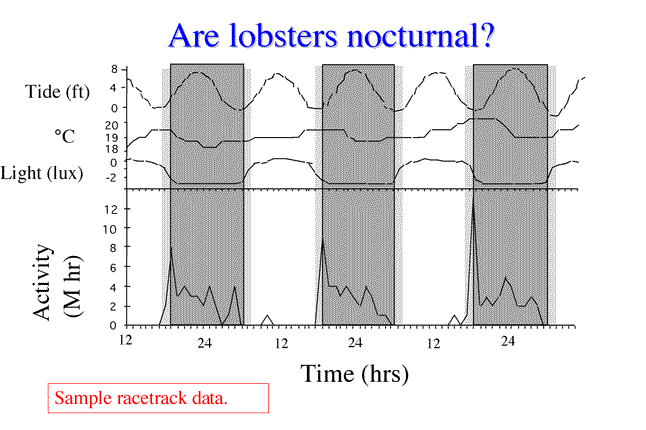
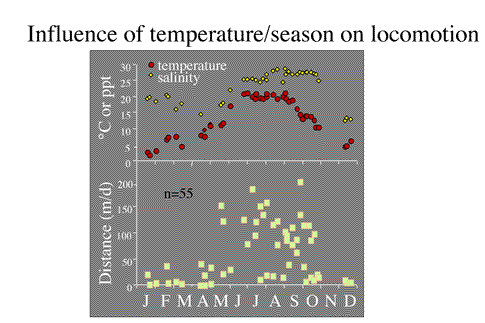
Cardioregulatory physiology
The heart rate of lobsters is regulated by circulating hormones and the cardioregulatory nerves. By lesioning the cardioregulatory nerves it is possible to distinguish between the two. This method is described below.
In two recent papers we have shown that both the transient cardiac response to temperature (Jury and Watson, 2001) and the cardiac response to drops in salinity are mediated by the cardioregulatory nerves (Fig. 11; Dufort et al., submitted).
